Among the many advantages of traveling in an RV is the ability to have all the modern conveniences of home with us as we travel. Keeping perishable foods safe and cold in an RV refrigerator is a real luxury while traveling and camping. Not only can we create healthy meals, but we can also have cold beverages handy as well as an absolute necessity of fine living – ice cream!
Having an RV refrigerator also gives people who have the need to keep medications refrigerated the ability to travel without concern. And when you have an RV refrigerator, gone are the days of soggy food and monitoring ice meltage.
But what exactly is an RV refrigerator and how does it work? Don’t they work the same way traditional residential fridges work?
We’ll answer all these questions and more in today’s post. So grab a cold beverage, some cream for your coffee, a cold beer – or (better yet!) some ice cream, gelato, or a fine sorbet – and let’s get to it.

The ability to maintain properly frozen ice cream is a priority for some people (not naming names), and in order to do that, we need to be able to maintain consistently cold temperatures.
- 1) What is an RV Refrigerator?
- 2) How Does an RV Refrigerator Work?
- 3) That’s Cool! Does an RV Refrigerator Have to Run on Propane?
- 4) How is an RV Fridge Different from a Residential Fridge?
- 5) The Pros & Cons of an RV Refrigerator
- 6) Do RV Refrigerators Work Better On Gas Or Electric?
- 7) Can You Use Your RV Fridge While You Drive?
- 8) Can You Replace Your RV Refrigerator?
- 9) Conclusion
What is an RV Refrigerator?
An RV refrigerator is a fridge that works on whatever type of power is supplied to an RV at any given time. This could be 12V power supplied by the engine’s alternator, 120V power from plugging into a campground shore power pedestal, or power supplied by LP (liquid propane) gas.
How Does an RV Refrigerator Work?
Even though the end result is the same as a standard 120V residential refrigerator (a box full of cold and/or frozen food), RV refrigerators don’t achieve that goal the same way. Your household refrigerator uses a compressor to run its cooling cycle, but a traditional RV refrigerator is different. It is what is known as an absorption refrigerator, and it works differently.
Absorption refrigerators have been used in RVs for many, many years. The reason for their popularity in RVs is the fact that they can not only run on electricity, but also on propane gas. This is important since RVs need their refrigerator to continue functioning, even when they’re not hooked up to any source of electricity (which boondockers like us usually are not).
Diagram showing the absorption refrigeration cycle (photo courtesy of Wikipedia)
The absorption process works (basically) like this:
- Heat is supplied to a liquid refrigerant (typically ammonia and water), causing the mixture to boil and turn into a gas
- The now gaseous refrigerant travels through a separation chamber where the water vapor condenses back to a liquid
- The liquid water returns to the absorption chamber (9)
- The gaseous ammonia continues to rise through a condenser coil located near the top of the refrigerator where the heat is extracted (to the outside air), causing the ammonia to condense back to a liquid form
- Hydrogen gas (released during the condensing cycle) is separated and returned to the absorption chamber (9)
- The cooled, liquid ammonia now flows (due to gravity) down to an evaporator coil, drawing heat from the freezer/refrigerator compartments
- The heat absorbed from the interior of the refrigerator causes the liquid ammonia to return to gas form
- The ammonia gas continues to flow toward the absorption chamber
- In the absorption chamber, the ammonia gas mixes with the water that was returned to the absorption chamber in step #3, and is now ready to repeat the cooling cycle
While all of that sounds complicated, it’s an amazingly elegant system. It’s a process that seems to defy logic, but it’s what allows you to generate heat by burning propane… and to then use that heat to freeze your food!!
That’s Cool! Does an RV Refrigerator Have to Run on Propane?
The advantage that the absorption refrigeration process has is that the heat needed to boil the refrigerant mixture can come from ANY source. Propane is a great choice because it’s readily available, it burns cleanly and easily, and it can be stored in a compact space (since it’s stored in denser liquid form, but it’s burned as a gas). But it’s not the ONLY choice.
RV refrigerators generally have a second heating source: a 120V AC-powered heating element. Thus, they’re commonly referred to as 2-way refrigerators, since there are TWO ways to initiate the cooling process.
And for smaller RV refrigerators, you can also add a 12V heating element (you see where this is going, right?). Adding this third heating source means these fridges are known as 3-way refrigerators: they can cool using (1) propane, (2) 120V AC, or (3) 12V DC power. Because generating heat takes a lot of power, these 3-way RV refrigerators usually only operate on 12V DC power only when the RV’s engine is running, so the engine’s alternator can provide the 12V power in order to prevent the RV’s battery(ies) from being drained. And they’re almost always on the smaller side.
If you see a vent on the outside of an RV in the area where the refrigerator is located, you know that RV has an absorption refrigerator (or was designed to have one), because the heat generated when the fridge is running in propane mode needs to vent to the outside.
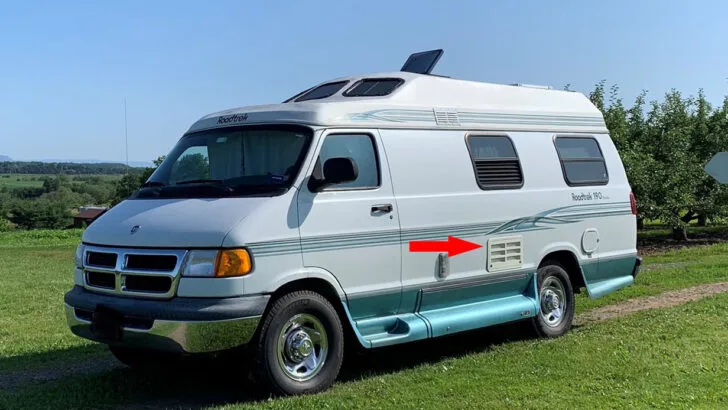
The red arrow points to a refrigerator vent on this Class B RV. The vent indicates that this Roadtrek has an absorption refrigerator.
How is an RV Fridge Different from a Residential Fridge?
As we already described above, the biggest difference between an RV refrigerator and the model you’re used to in your sticks and bricks house is the fact that RV refrigerators use a different process for creating cold.
There’s no compressor in an absorption RV refrigerator, so as we noted above it uses heat and a chemical reaction (ammonia, water, and hydrogen) to cool the unit. And that heat is provided by any of the power sources noted above.
Typical RV refrigerators are smaller than residential models. They usually have a capacity of 6-14 cubic feet, though newer high-end RVs are being manufactured with larger and larger fridges, some with double doors and up to 17 cubic feet of storage.
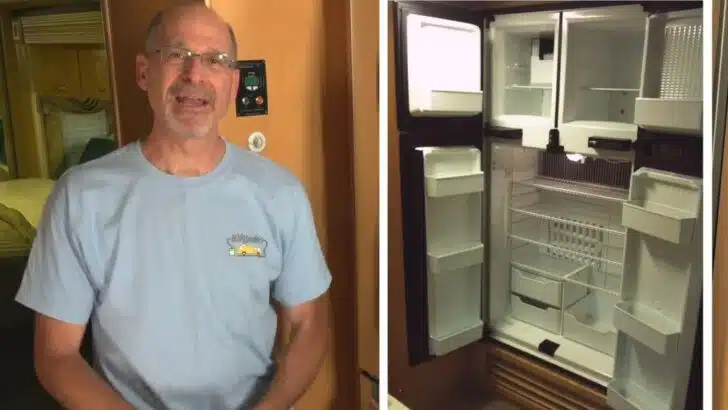
We originally had a bi-fuel RV refrigerator, but we had numerous issues with the unit and ended up replacing it.
A residential refrigerator, as a rule, is larger than any standard RV refrigerator, with more storage capacity in both the fridge and freezer. It has a compressor, so it requires a constant source of 120-volt AC power such as a campground power hookup, or a sufficient battery bank coupled with an inverter to supply that 120-volt power when the RV is not plugged into shore power. A generator can also supply power to a residential refrigerator in an RV.
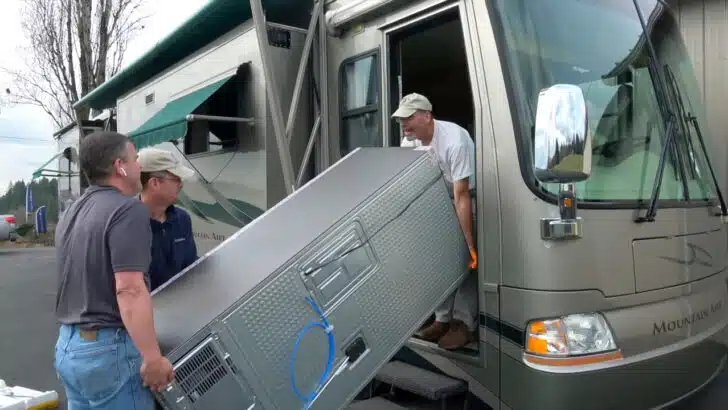
We replaced our original RV refrigerator with a residential unit, but had to do some fancy footwork to get it into our motorhome.
Residential refrigerators are not designed to withstand the bumps and turns and harsh terrain over which most RVs travel, and this can have an impact on the lifespan of the fridge. RV refrigerators have no moving parts, so they’re less susceptible to the “abuses” of being in a house that rolls down the road.
Residential refrigerators also don’t have latches to keep the doors from flying open while underway on the road, so a latching system needs to be added. RV refrigerators come with doors that latch closed, ensuring the contents stay put while underway.
When you’re not hooked up to shore power, RV refrigerators are much more power-friendly. Running off of propane means that they only require a small 12V draw to power the “brains” of the fridge. We have a residential refrigerator in our motorhome, and we can tell you that a robust power plant is needed to run our large fridge and freezer while we’re out boondocking in the middle of nowhere, which is our preferred camping mode. We have a substantial lithium battery bank (600 amp-hours) fed by an equally substantial solar array (1,300 watts). A large inverter completes the package, allowing us to power our residential fridge for extended periods of time without being hooked up to a power source. And without running our generator.
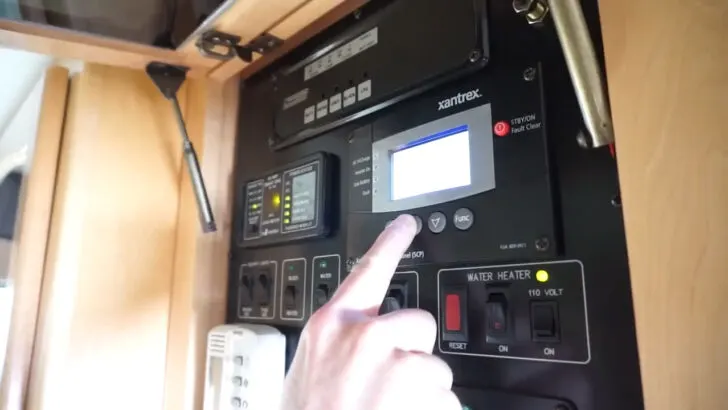
Our RV refrigerator and our inverter run 24 hours a day, 7 days a week, 365 days a year.
Because we live in our rig full-time, a residential fridge works best for us. It may also work best for families who would otherwise need to be constantly stocking a smaller RV refrigerator. But a residential fridge is certainly not the best choice for every RVer. As always, specific needs and resources need to be considered in every unique situation.
The Pros & Cons of an RV Refrigerator
As with anything else, there are pros and cons to RV refrigerators. What matters, though, is what the balance of both means to your particular situation. For many, the benefits far outweigh the drawbacks, but for others (like us), the reverse is true.
Benefits of an RV Fridge
The ability to fuel your RV fridge in multiple ways — 120-volt AC plug-in power, liquid propane, or even 12V DC is one of the main benefits of an absorption refrigerator. When being used in propane mode, an absorption fridge uses very little electrical power, making it a very popular option for boondocking.
However, there are a couple of drawbacks to this type of cooling as well.
Drawbacks of an RV Fridge
Any time you’re using propane you have the potential for fire. RV refrigerators have a good track record of safety, but having a flame burning in your RV does pose some level of risk. And RV fires can and have started at the fridge.
Second, absorption RV refrigerators are very expensive. This means that you’ll be looking at replacing a high-cost item should your absorption fridge stop working and be difficult or impossible to repair.
Absorption RV refrigerators are also a bit more finicky than their residential counterparts. Because the cooling process requires the flow of gas and liquids through a maze of pipes and chambers, the RV needs to be close to level in order for the fridge to work at its best. Too far off, and the cooling process won’t run completely, resulting in inefficient/ineffective refrigeration.
They also don’t have a defrost cycle the way a residential refrigerator does. That means, over time, the cooling fins in an RV refrigerator will get coated with frost and ice, requiring you to manually defrost the unit to keep it operating properly.
The nature of the cooling cycle also means that they’re subject to the influence of ambient temperatures. A rule of thumb says that absorption fridges will cool to about 40 degrees below ambient temps, and the freezer compartment to 25-30 degrees below the fridge temperature. So, absorption refrigerators may struggle to get as cold as compressor fridges are able to get, and they don’t cool as consistently. That can mean your freezer won’t keep your ice cream solid (NO!) and produce may spoil more quickly as a result of fluctuations in temperature in the refrigerator.
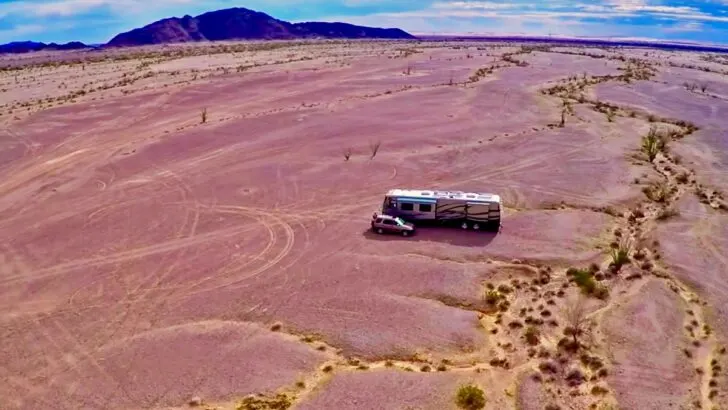
When you boondock in the middle of the desert as much as we do, you really don’t want your fridge and freezer contents to be subject to the whims of ambient temperatures.
Do RV Refrigerators Work Better On Gas Or Electric?
Once the cooling process is started, it runs the same regardless of the source of heat. And during the ongoing, normal operation of the refrigerator, any of the three possible heating sources will run the refrigerator pretty much the same.
But there is a difference in the amount of heat each source can supply to kick things off. Propane is, without a doubt, the most efficient way to run an absorption refrigerator. Once the propane is ignited, it supplies the largest amount of heat to the burner chamber, getting the cooling process started quickly. Running on 120V AC power is the next best choice, with the 12V DC heating element being the least powerful way to run.
As a result, if you’ve stored your RV and need to cool a warm refrigerator down the quickest, we’d suggest running it on propane (at least to start). That will get the fridge and freezer compartments cooled down the quickest, allowing you to load the fridge up with food for your trip. Regardless of the source of cooling power, be sure to allow enough time for the refrigerator to cool down completely and get stable before loading it up, if at all possible. Otherwise your food (and trip) could be spoiled.
Can You Use Your RV Fridge While You Drive?
You can absolutely use your RV refrigerator while you drive.
Most of us travel for extended periods as we make our way from one place to another. During those drive times, we all need to continue to keep our food cold and safe. You can do this by running your RV’s refrigerator in propane mode, or, if it’s a 3-way refrigerator, in 12V DC mode since the engine’s alternator supplies the power.
There is some controversy around driving with a fridge running on propane, and with good reason, as there are some risks involved in doing this. It is recommended that you turn off your propane supply before hitting the road, as a severed propane line or any other propane leak can be ignited by a spark, causing an explosion in an accident. This is why some tunnels prohibit propane-toting rigs from proceeding through them with the propane turned on.

Not all tunnels allow rigs with propane tanks on board (or at least not with it turned on).
The alternatives are to run your fridge in 12V DC mode while you’re driving (if you have a three-way RV refrigerator), or to run it in AC mode with the generator running.
Many RVers run their fridges in propane mode while driving and accept the risk. Doing this, however, you must still obey the laws related to driving through tunnels (in some states) and you should always turn off your propane source at fueling stations. Propane requires care and caution at all times.
One final note: Most RV refrigerators, if sufficiently cold when turned off and left closed for the duration of the time, will only lose about 4-6 degrees in 8 hours. So many RVers choose to keep their fridges turned off completely while driving.
Can You Replace Your RV Refrigerator?
Yes. You can replace your RV refrigerator with another fridge of a similar size or type, or you can possibly retrofit a larger fridge if the space in your galley allows.
We’ve had to replace the refrigerator in our RV twice in the years that we’ve owned it. We started out with a traditional bi-fuel RV refrigerator (a Norcold 4-door 14-cubic foot model), but when it failed catastrophically, we opted to upgrade to a residential fridge (for the larger capacity, more consistent and colder temps. You know… ice cream).
We later had to replace that residential unit, and while that took some doing, our current refrigerator (a Samsung 18 cubic foot French door model) has worked out well for us. We have no need to defrost, no fire hazard from propane, and we have colder, more consistent temperatures. All a win, and made possible as a choice for camping off the grid because of our large lithium battery and solar panels.
Conclusion
We hope this information is helpful in bringing you a better understanding of RV refrigerators in general, including how they work, and maybe why they sometimes don’t work all that well.
If your RV refrigerator is not performing as you think it should, be aware of where you park your RV. Keep your rig as level as possible, and park in the shade if you can (or at least with the fridge side of the RV facing North). You can also try installing a muffin fan or computer fan inside the fridge or on the back near the coils. And finally, you can check the fridge’s door gasket for leaks. Close the door with a dollar bill in between the body of the fridge and the door, then give a tug on it to check the strength of the seal. If it’s weak, you can replace the gasket. If none of these simple measures are helpful, you’ll need to troubleshoot your fridge using instructions provided by the manufacturer or seek out the services of a qualified technician.
Geek Out with Us Every Week
Join our newsletter to learn about all things RV-related. Every week we offer free tips, tricks, product reviews, and more to our online community of RVers. So, whether this is your first time on the road or you’re a seasoned expert, we’d love for you to geek out with us!

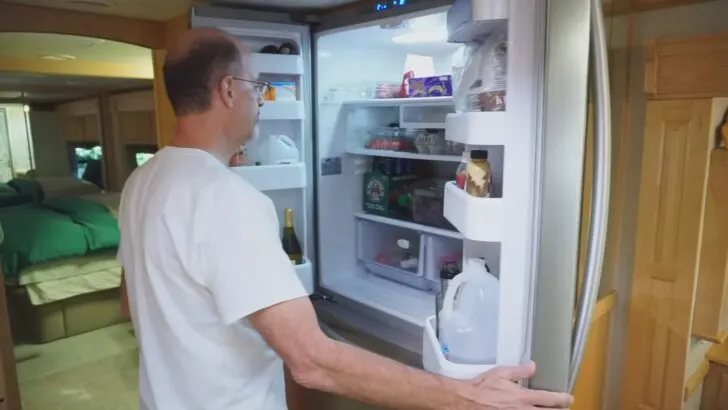
Tim
Wednesday 22nd of June 2022
My Dometic fridge has way way too much condensation. What are the causes and how do I fix it
TheRVgeeks
Wednesday 22nd of June 2022
Hi Tim. Sorry to hear about that, we know what a pain it can be. Typically, too much moisture inside a refrigerator compartment is a sign of a seal failure allowing too much ambient air to enter (bringing moisture). We've read that you can use a dollar bill to test the seal. Holding part of the dollar bill outside, close the door onto the other end. Slowly/gently pull the bill out. There should be some resistance to it coming out. If there isn't, then the door isn't sealing properly in that spot, and likey needs to be replaced. You can move the dollar bill to other locations and close the door on it again to test there.
Tami
Thursday 3rd of February 2022
We are heading south for the first time in our 2001 van with the original 3 way fridge. 10 degrees Fahrenheit at night and we are staying in a hotel. Can my fridge be damaged, and will it work in freezing temperatures? Thanks for your help
TheRVgeeks
Sunday 6th of February 2022
Hi Tami! We've never heard of an RV fridge freezing or having problems in cold temperatures, with the possible exception of an ice maker water line. We're guessing that if you have a van with a 3-way fridge, it's not equipped with an ice maker anyway. But we've never read anything about low temperatures being an issue for an RV fridge.
TJLee
Friday 20th of August 2021
I have a RV 3-way fridge on the passenger side. When making a camping reservation, I look for a site facing west (1st choice) or north (second choice). This puts my fridge facing north or east; better than facing west or south. I still ponder the combination of solar and an RV fridge. Sun helps the solar but compromises the fridge. Shade helps the fridge but compromises the solar. I choose to boondock in the shade in hot weather, therefore I never added solar.
Thanks for the objective comparison.
TheRVgeeks
Friday 20th of August 2021
Good points. We've always done a similar thing (though with our fridge on the driver's side, we tend to face east or south to keep it out of the sun). Of course, our residential refrigerator is much less affected by that than an RV fridge... and solar is much more necessary for all our power draw. ????
Pat Parker
Wednesday 18th of August 2021
Thanks for the tips great as always